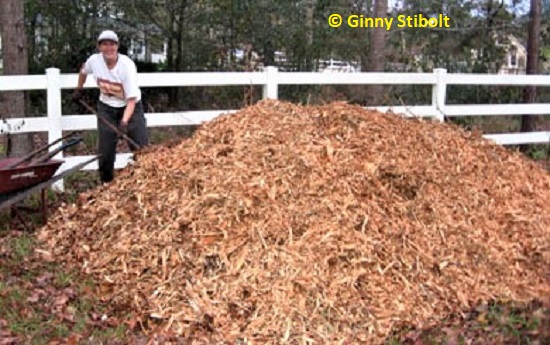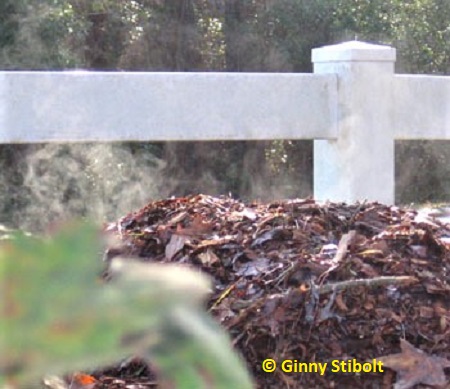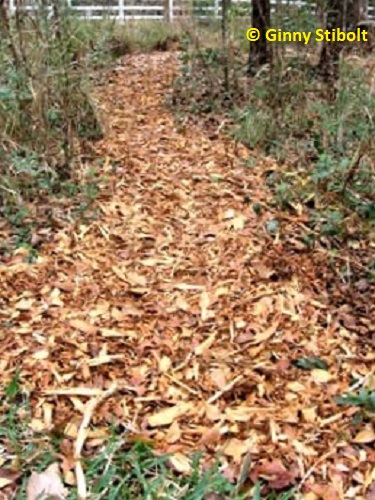Follow the yellow mulch road
by Ginny Stibolt
The other day, I was removing invasive wedelia (Sphagneticola
trilobata) from the back meadow area when I heard the distinctive
drone and periodic roars of a tree shredder from across the lake. I
threw down my work gloves, hopped on my bike, and found the tree guys
working for a neighbor. I asked for their load of freshly chopped wood
and they agreed. After all it saved them the time and expense of a trip
to the landfill. A little while later I was the proud owner of a huge
pile of yellow mulch. Of course, the color of the mulch really depends
upon the type of tree being shredded, but for this load, it was the
yellow of a newly cut sweet gum and oak trees.
Tree mulch is sustainable
This is a mix of shredded wood and leaves--the tree parts
that have been run through a chipper. As a mulch, it consists mostly
of nicely chopped wood chips mixed with some thin twigs that slide through
the shredder. This mulch will last for a year or more as a garden or
pathway mulch. It will eventually decay and become part of the soil.
Because nothing has been added to it, the look is quite
natural, and if leaves fall on it, no removal is necessary--it all blends
together. For beds that are in full view, you'll probably want to pull
out or bury the sticks as you lay it to reduce the rustic look.
In all respects, this is the most sustainable mulch. Tree
trimmers save gas, time, and money by leaving it in the neighborhood
instead of hauling it off to a landfill and paying a dumping fee. You
save gas and money by not buying it from a store or paying for delivery.
Stress on landfill capacity is reduced. Commercial mulch (most often
bagged in plastic) uses energy in production, packaging, disposal, and
delivery. Also, because the demand for cypress mulch is so high, old-growth
cypress forests are being torn down just to keep up with demand and
that certainly is not sustainable.
Normally, the tree trimmers are quite happy to leave the
load of wood chips in the neighborhood. Once we asked some guys trimming
for the power company and they were somewhat reluctant to give us their
mulch. I think it was that they were being paid by the hour and were
not paying the dumping fee--ultimately we pay for this service through
our utility bills. We did get that load, though. Another time the tree
trimmers had plans for their load, but it certainly does no harm to
ask.
(Update: Over the years we've had
more than twenty loads of chips delivered. All of this good stuff has
been absorbed into our landscape.)
A fresh new pile!!
I'd used the last of my previous pile a month ago and I'd
been feeling naked, garden wise, without a supply of mulch. This
is why I so quickly left my wedelia chore out back and sought out the
woodcutters.
When procuring a new batch of mulch, we have it dumped
outside our fence out front. This is an easy location for the
tree guys to dump their loads. And then my husband and I can take a
couple of days to shovel it over the fence. After shoveling this
load, though, I'm lobbying for a gate in the fence so the next pile
could be dumped right where we want it. That way there might be fewer
aches and pains.
(Update: We did not put in a gate,
but made one of the posts removable. This way when a load is coming
in, we remove the post and the slats so the truck has a 16' opening
to back into. We covered the removable post hole liner with a plastic
box so chips are not dumped into the hole. After a load is dumped, there
is sometimes some clean up work to do, but it's a minor inconvenience
when compared to moving a whole pile. Years later, we gave the fence
away, so that problem is solved.)
This load was a nice mixture of oak, sweet gum, and a
Christmas tree, probably a balsam fir. One day after we finished pitching
it over the fence, this new pile was steaming in the morning sun as
its microbes started working. I've already used some of this mulch to
apply a new coating for all the paths in the front meadow. The mulch
can sit in this out-of-the-way corner of the front meadow until I use
it all up and then I'll be listening for that characteristic drone of
a wood chipper in the neighborhood again.
Follow the yellow mulch road
I urge you to search out tree trimmers in your neighborhood, so you
too can take the yellow mulch road to sustainable gardening.
|




